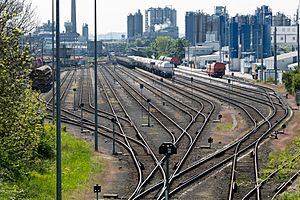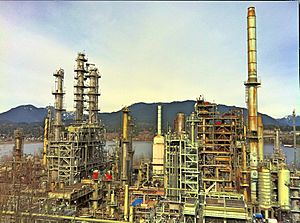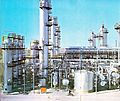Oil refining facts for kids

Oil refining is the name for a number of processes from chemical engineering, which transform crude oil into useful products such as different fuel oils, Liquefied petroleum gas, gasoline, kerosene or diesel oil. These transformation occur in plants called petroleum refineries. The transformations are done in many steps. The refineries are large industrial complexes, that have many different sub-units, and facilities. Each refinery has its own unique arrangement and combination of refining processes. The exact setup of the refinery is largely determined by the its location, desired products and economic considerations.
Modern petroleum refineries process as much as 800,000 to 900,000 barrels (127,000 to 143,000 cubic meters) per day of crude oil.
Images for kids
-
Anacortes Refinery (Marathon), on the north end of March Point southeast of Anacortes, Washington, United States
-
A petrochemical refinery in Grangemouth, Scotland
-
The oil refinery in Haifa, Israel, is capable of processing about 9 million tons (66 million barrels) of crude oil a year. Its two cooling towers are landmarks of the city's skyline.
-
Storage tanks and towers at Shell Puget Sound Refinery (Shell Oil Company), Anacortes, Washington
-
Refinery of Slovnaft in Bratislava
-
Sample of crude oil (petroleum)
-
Cylinders of liquified petroleum gas
-
Sample of gasoline
-
Sample of kerosene
-
Sample of diesel fuel
-
Pile of asphalt-covered aggregate for formation into asphalt concrete
See also
 In Spanish: Refinería de petróleo para niños
In Spanish: Refinería de petróleo para niños




















